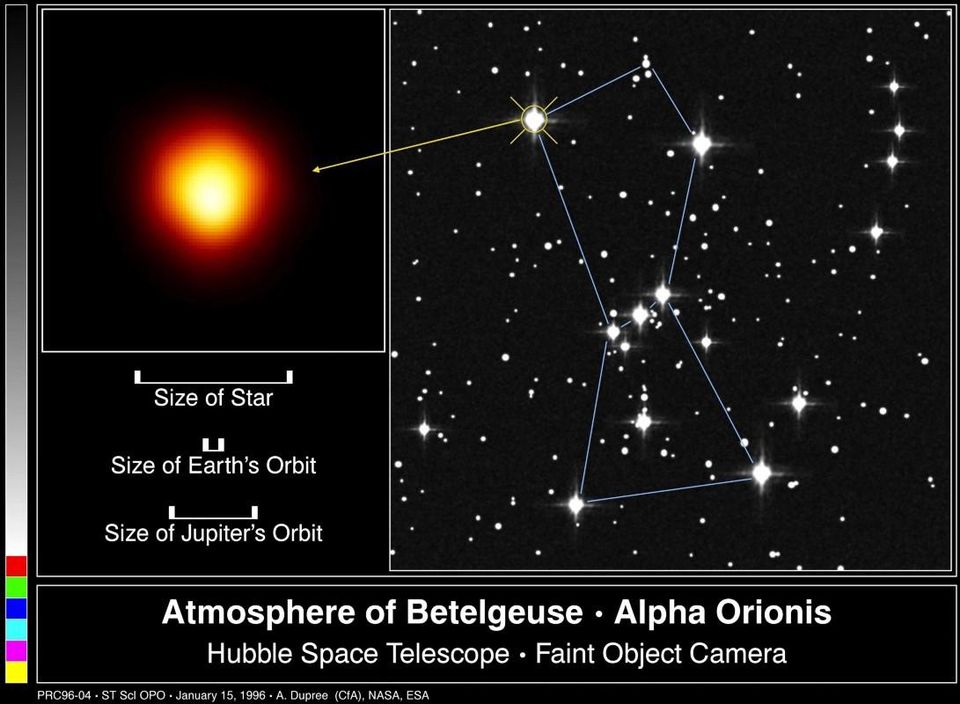A giant star is acting strange, and astronomers are buzzing.
The red giant Betelgeuse is the dimmest seen in years, prompting some speculation that the star is about to explode.

In a recent survey, astronomers discovered that more than hundred stars had disappeared in the night sky over a span of less than 50 years. That’s really a lot. And now, one of the brightest star in the sky – the giant red star Betelgeuse, which marks the hunter’s right shoulder – is the dimmest it’s been in almost a century. And many believe it is about to explode.
Normally, Betelgeuse is among the 10 brightest stars in the sky. However, by mid-December, the star had faded so much it wasn’t even in the top 20 and that the outline of Orion is noticeably different.
Betelgeuse Mysterious Dimming
To be clear, dimming alone isn’t all that odd for a star like Betelgeuse as it’s known as a variable star, and thus shifts in brightness.
However, it is unusual for one of the sky’s most prominent points of light to fade so noticeably. This fact brings scientists to consider another exciting possibility: Betelgeuse explosion and death.
Recent studies suggest that the star will most likely explode within the next million years, and perhaps as soon as 100,000 years from now. Or … maybe Betelgeuse has already exploded and we have not yet seen it happen.
What do we know about Betelgeuse?
Huge, red stars like Betelgeuse live fast and die violently, exploding in stellar events called supernovae that are visible across vast distances. So, while Betelgeuse is a relatively young star, astronomers know that it is nearing the end of its life.
The biggest question now is when it will explode in a supernova:
BETELGEUSE! BETELGEUSE! BETELGEUSE!
— Sarafina Nance (@starstrickenSF) December 23, 2019
a massive red supergiant in the constellation Orion, it's ~200 parsecs away & has fascinated humans for centuries with its signature bright red color and gargantuan size.
the biggest question now is when it will explode as a supernova.
Betelgeuse is huge and bloated, wielding 20 times the sun’s heft. If you swapped out the sun and replaced it with Betelgeuse, the red star would swallow Mercury, Venus, Earth, Mars, the asteroid belt, a couple of spacecraft, and maybe Jupiter; Saturn would suddenly be quite toasty.
It’s also relatively close to our solar system, in cosmic terms, estimated to be in the neighborhood of 600 light-years away. So, when this star detonates, the explosion will be bright enough to cast shadows on Earth at night and will be visible during the day for a few months, at least. Then, the star will fade from our sky.
What will happen when Betelgeuse blows?
Nothing. Even though Betelgeuse is nearby in astronomical terms, it’s nowhere near close enough for the explosion to affect life on Earth.
Astronomers calculate that it’ll take about six million years for the shock wave and any cold, diffuse debris to reach the solar system, and even then, the sun’s protective bubble will shield us from the splattered star guts.
Instead, once astronomers see that Betelgeuse is going to go supernova, you should get to a clear northern sky as quickly as possible and enjoy the show.
So, Will Betelgeuse Explode and Die?
This is the big mystery, and it’s one of the reasons why the star’s current behavior is intriguing. Scientists suspect that a precipitous drop in brightness could portend a star’s demise.
As massive stars near the end of their lives, they experience insane and violent mass loss.
In theory, all that ejected dust could shroud and darken the nearly dead star, causing it to dim from our perspective right before it goes supernova.
In practice, though, it’s not yet certain whether stars are darkest before they blow.
Betelgeuse Dimming is Unusual
Yes. Betelgeuse is classified as a semiregular variable star, meaning that its brightness semiregularly changes.
Decades of photometric data show that Betelgeuse brightens and dims in cycles, with one notable cycle vacillating on a roughly six-year timescale, and another rising and falling every 425 days or so.
Regarding #Betelgeuse's "historic" dimming, here's V-band & photovis magnitude estimates from @AAVSO database over past century.
— Eric Mamajek (@EricMamajek) December 21, 2019
*You* try maintaining constant luminosity w/~20 solar masses spread out within the size of Jupiter's orbit, w/convection & nucleosynthesis is 3D! pic.twitter.com/e2kojEZXAC
The star is not strictly periodic, and the range of light variations changes from cycle to cycle. But if it keeps getting fainter, then all bets are off.
When will Betelgeuse explode?
Recent studies suggest that the star will most likely explode within the next million years, and perhaps as soon as 100,000 years from now. Or … maybe Betelgeuse has already exploded and we have not yet seen it happen.
It takes light from this star about 600 years to reach us, meaning that we’re actually observing the star as it was 600 years ago.
If we do see it detonate in our sky any time soon, that means the star actually blew up sometime during the European Middle Ages, and light from the blast is just reaching Earth. More headlines on Strange Sounds and Steve Quayle. [AstroTel, NatGeo]













When will Betelgeuse explode?
The Answer It Already Has
What most of the scientists have overlooked is the fact
that we never see space in our time it is always the past
it takes a long long time for the light to reach us
all the light is very old light as for the missing stars the same rule applies it just took so long for us to see them disappear many of the stars that you see in the sky have already burned out or exploded
I have been an astronomer for quite a few years i have seen allot of stuff the 4 naked eye planets meteor showers
and 44 constellations of the night sky and the Orion nebula